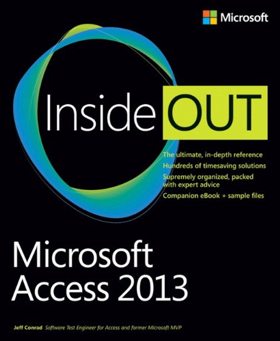| Access 2013 Inside Out |
|
Author: Jeff Conrad This book isn't as comprehensive as its title suggests, which comes as a something of a shock. The author of Access 2013 Inside Out is a software test engineer for Access, and he used to be an Access MVP. So there’s no doubting the level of knowledge he has of Access. As such, I was expecting to read a book that warranted at least a 4 rating, more likely a 4.5 or even a top level 5. However, reading the introduction, I discovered that the book is divided into eight major parts. Part 1 shows how to create and work with the new Access Service web apps – great. Part 2 shows how to create and work with tables in a desktop database, again, just what you’d expect. Then I read ‘Part 3 to Part 8, which includes Chapter 12 through Chapter 27, can be found in the Companion Content section on the book’s catalog page. The Companion Content also includes seven additional articles with important reference information.’ So of a 27 chapter book, which I had chosen to read in a printed format, I only get 11 chapters?
I do have some sympathy with the situation the authors and publishers find themselves in, as the length of the book would be twice as long if they included the other material, but why not call this ‘Access 2013 Web Development Inside Out’? That way at least I’d know what I was getting. What’s even less forgivable is the fact that, so far as I can tell, the Kindle Edition is also limited to half the book, with the extra chapters only available as a PDF download. However, if you’re mainly interested in the web aspects of Access – and many applications will fall into that category – then what you get in the book is thorough. Conrad starts with a couple of general introductory chapters to Access and its web app interface, then goes on to look at table design. There’s a very good chapter on data macros in web apps next. If you’re not familiar with Access 2013, data macros let you respond to table events without writing full VBA. The sort of thing you can do with them is to make sure an invoice has all the correct details in the invoice line items before you save the record; or to create new records based on the equivalent ones in the previous week in a scheduling app. Queries in web apps comes next, followed by two good chapters on working with views and advanced view design. Part 1 of the book closes with a chapter on using macros to automate a web app by attaching macros to view events. This was another good chapter.
The second part of the book consists of three chapters on working with desktop databases in Access, showing the desktop database interface, how to design tables for desktop database use, and how to modify table designs. I found it difficult to work out why these three chapters were in this part of the book rather than the online part. The downloadable companion content covers database queries, forms and reports for desktop databases; macros, VBA, and customizing the application interface. At the end of this (part) of the book I certainly felt it covers the main aspects of designing apps for the web in Access well. If this is what you need to know about, it’s a good buy. If you need to cover both web and desktop databases, it’s much less satisfactory.
|
|||
| Last Updated ( Wednesday, 07 May 2014 ) |

